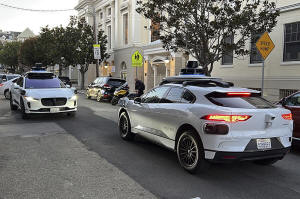Waymo's robotaxis now open to anyone who wants a driverless ride in Los
Angeles
 Send a link to a friend
Send a link to a friend
 [November 13, 2024] By
MICHAEL LIEDTKE [November 13, 2024] By
MICHAEL LIEDTKE
Waymo on Tuesday opened its robotaxi service to anyone who wants a ride
around Los Angeles, marking another milestone in the evolution of
self-driving car technology since the company began as a secret project
at Google 15 years ago.
The expansion comes eight months after Waymo began offering rides in Los
Angeles to a limited group of passengers chosen from a waiting list that
had ballooned to more than 300,000 people. Now, anyone with the Waymo
One smartphone app will be able to request a ride around an
80-square-mile (129-square-kilometer) territory spanning the second
largest U.S. city.
After Waymo received approval from California regulators to charge for
rides 15 months ago, the company initially chose to launch its
operations in San Francisco before offering a limited service in Los
Angeles.
Before deciding to compete against conventional ride-hailing pioneers
Uber and Lyft in California, Waymo unleashed its robotaxis in Phoenix in
2020 and has been steadily extending the reach of its service in that
Arizona city ever since.
Driverless rides are proving to be more than just a novelty. Waymo says
it now transports more than 150,000 weekly trips in its robotaxis, a
volume of business numbers that helped the company recently raise $5.6
billion from its corporate parent Alphabet and a list of other investors
that included venture capital firm Andreessen Horowitz and financial
management firm T. Rowe Price.

“Our service has matured quickly and our riders are embracing the many
benefits of fully autonomous driving," Waymo co-CEO Tekedra Mawakana
said in a blog post.
Despite its inroads, Waymo is still believed to be losing money.
Although Alphabet doesn't disclose Waymo's financial results, the
robotaxi is a major part of an “Other Bets” division that had suffered
an operating loss of $3.3 billion through the first nine months of this
year, down from a setback of $4.2 billion at the same time last year.
[to top of second column] |

Two Waymo driverless taxis stop before passing one another on a San
Francisco street on Feb. 15, 2023. (AP Photo/Terry Chea, File)
 But Waymo has come a long way since
Google began working on self-driving cars in 2009 as part of project
“Chauffeur.” Since its 2016 spinoff from Google, Waymo has
established itself as the clear leader in a robotaxi industry that's
getting more congested.
Electric auto pioneer Tesla is aiming to launch a rival “Cybercab”
service by 2026, although its CEO Elon Musk said he hopes the
company can get the required regulatory clearances to operate in
Texas and California by next year.
Tesla's projected timeline for competing against Waymo has been met
with skepticism because Musk has made unfulfilled promises about the
company's self-driving car technology for nearly a decade.
Meanwhile, Waymo's robotaxis have driven more than 20 million fully
autonomous miles and provided more than 2 million rides to
passengers without encountering a serious accident that resulted in
its operations being sidelined.
That safety record is a stark contrast to one of its early rivals,
Cruise, a robotaxi service owned by General Motors. Cruise's
California license was suspended last year after one of its
driverless cars in San Francisco dragged a jaywalking pedestrian who
had been struck by a different car driven by a human.
Cruise is now trying to rebound by joining forces with Uber to make
some of its services available next year in U.S. cities that still
haven't been announced. But Waymo also has forged a similar alliance
with Uber to dispatch its robotaxi in Atlanta and Austin, Texas next
year.
Another robotaxi service, Amazon's Zoox, is hoping to begin offering
driverless rides to the general public in Las Vegas at some point
next year before also launching in San Francisco.
All contents © copyright 2024 Associated Press. All rights reserved |